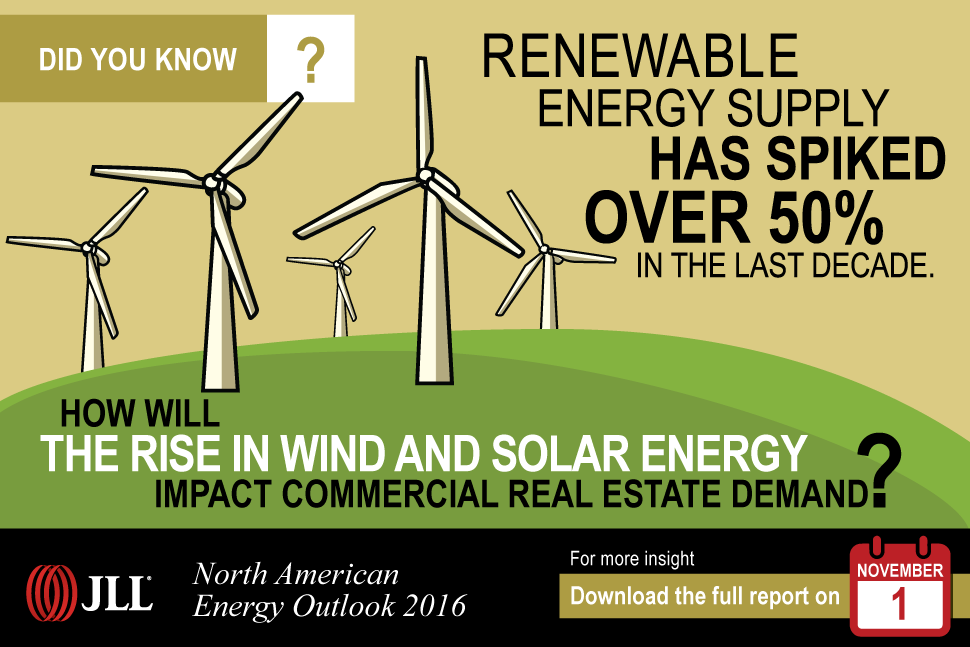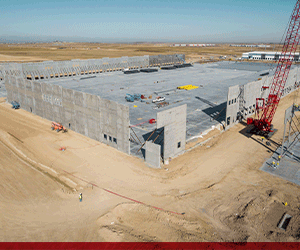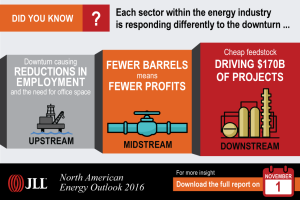 Denver, CO – With oil prices fluctuating, the North American energy industry is undergoing a major shift, forcing oil and gas companies to face tighter budgets and rethink office space for a modern workforce. According to JLL’s annual 2016 North American Energy Outlook, upstream and midstream oil and gas companies and the companies that serve them are at a critical juncture to move toward a slimmer, more flexible real estate portfolio.
Denver, CO – With oil prices fluctuating, the North American energy industry is undergoing a major shift, forcing oil and gas companies to face tighter budgets and rethink office space for a modern workforce. According to JLL’s annual 2016 North American Energy Outlook, upstream and midstream oil and gas companies and the companies that serve them are at a critical juncture to move toward a slimmer, more flexible real estate portfolio.
At the same time, the growing downstream industry is creating new demand for industrial real estate in places like western Pennsylvania, eastern Texas and the Gulf Coast. Meanwhile, the continued expansion of solar and wind energy production is creating new alternative energy clusters in Denver and California.
“A newer, leaner oil and gas industry will emerge from the downturn, and it’s only natural that real estate strategies will follow,” said to Bruce Rutherford, Co-Lead of JLL’s Energy group. “This is a watershed moment for traditional oil and gas companies to rethink their real estate. Today’s market conditions are providing opportunities for companies to move toward more efficient space layouts and negotiate more flexible lease terms.”
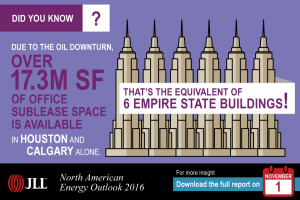 Turbulent oil prices spur new real estate strategies
Turbulent oil prices spur new real estate strategies
The downsizing of white-collar positions and therefore, office space in oil and gas firms, has caused an unprecedented flood of both sublease and direct space on to the market, especially in energy-heavy locations like Houston and Calgary. The availability of sublease space exploded to 22.6 million square feet in the top seven North American energy cities in the second quarter of 2016.
For markets heavily impacted by the downturn, reversing the trend will potentially take years. For this to occur, crude oil prices will need to stabilize, energy companies will then expand capital budgets, grow headcount and work through excess office space before returning to expansion mode.
Bright Spot: Booming downstream sector
The downstream sector has been in growth mode during the past several years, as the shale boom and decline in oil prices have fueled a revolution in the petrochemical industry. As cheaper energy inputs allow for the increased manufacturing of intermediate chemicals and finished plastic products, the sector is currently constructing or planning 268 projects across the U.S., costing approximately $170 billion, according to the American Chemistry Council.
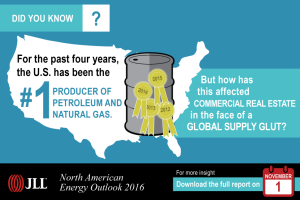 Along the Gulf Coast and in western Pennsylvania, the level of capital flowing into the downstream sector is spurring demand for specialized industrial projects and increasing demand for neighboring manufacturing and warehouse space. This demand for real estate coupled with a disposable income windfall for households due to lower gasoline, natural gas, and energy costs, is also spilling into the retail and multifamily markets.
Along the Gulf Coast and in western Pennsylvania, the level of capital flowing into the downstream sector is spurring demand for specialized industrial projects and increasing demand for neighboring manufacturing and warehouse space. This demand for real estate coupled with a disposable income windfall for households due to lower gasoline, natural gas, and energy costs, is also spilling into the retail and multifamily markets.
Bright Spot: Renewable energy revolution
Though still a smaller proportion of total energy production, renewable energy supply in the U.S. has spiked by 51.4 percent since 2006, according to the Energy Information Administration. The growth of wind and solar power is pushing demand for both office and industrial real estate from equipment manufacturers.
“We expect further expansion of renewables and the clean tech industry as new legislation and the increasing cost-competitiveness of wind and solar incite further development,” said Eli Gilbert, Vice President of Research at JLL and leader of the energy research group. “A diverse array of commercial real estate markets in North America will reap the benefits from this growing sector.”
 Denver, for example is growing into a renewable cluster with clean tech companies flourishing in the region. In fact, Colorado, specifically the Denver/Fort Collins market, has the highest concentration of wind manufacturing jobs in North America.
Denver, for example is growing into a renewable cluster with clean tech companies flourishing in the region. In fact, Colorado, specifically the Denver/Fort Collins market, has the highest concentration of wind manufacturing jobs in North America.
“Similarly, California and Arizona are emerging as top markets for solar energy,” said Gilbert. “With the highest concentration of solar company headquarters in the continent, California may become the next renewable energy hub.”
Infographics courtesy of JLL Research



